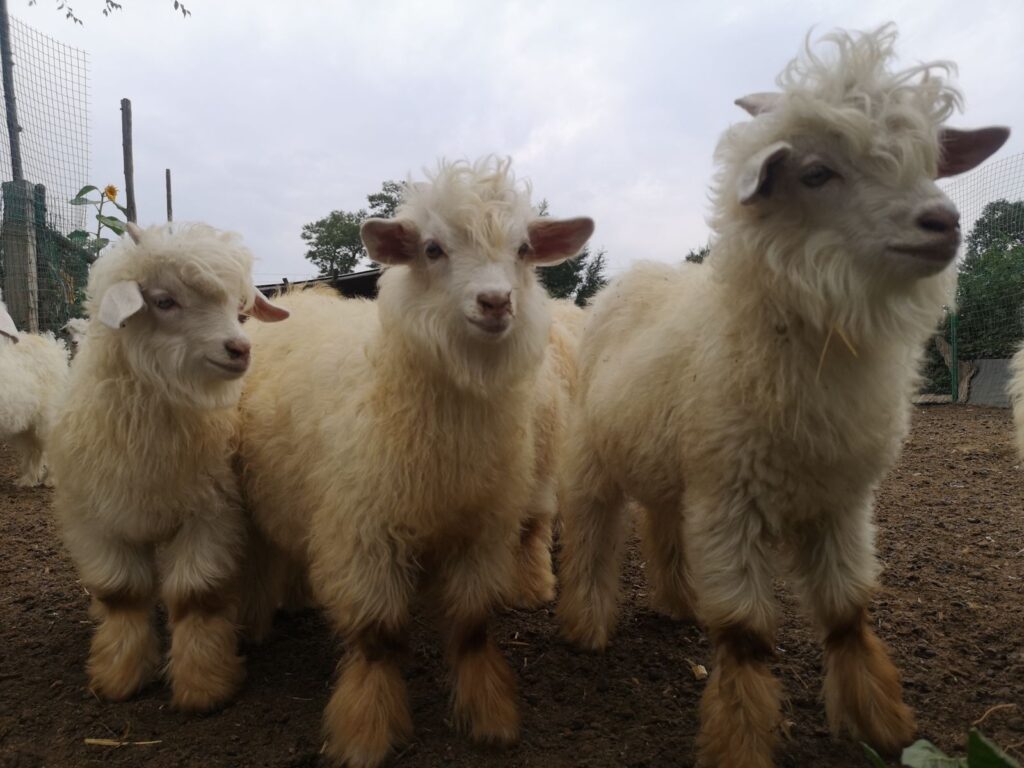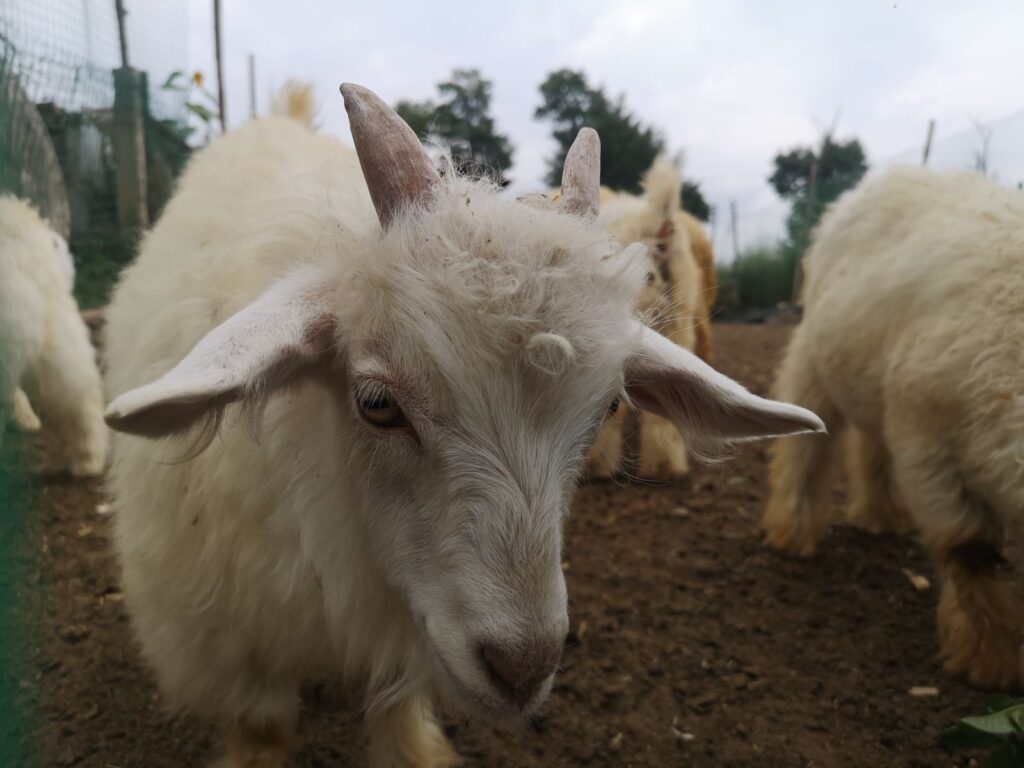Cashmere is one of the most luxurious pieces of clothing. Have you wondered how cashmere is harvested? There are certain ways of collecting fiber from cashmere goat. Sheep has to go through the shear process for wool fiber. Whereas some animals need haircuts. But collecting cashmere hair from goats is different. Harvesting cashmere is itself very difficult and unique.
How to Collect Cashmere from Goats?
Cashmere goats are very humble. The origin of Cashmere is from Kashmir, a place in the Himalayas. Winters are very harsh in the Himalayan regions. The fiber is the soft undercoat that grows to keep the goat warm from chilly winter.

After the winter, Cashmere sheds in early spring. There is no purebred cashmere goat as any goat can grow cashmere. But certain breeds produce more amount of cashmere fiber.
There are two different coats of fiber; guard hair and soft hair.
- Soft Hair: Most of the hairs on a Cashmere goat are guard hairs. These hairs can be short or long but are straight and coarse. After harvesting the fiber, it needs to be dehaired to remove the guard hairs. After dehairing cashmere fiber you can see soft and luxurious soft cashmere fiber. The quality of the fleece depends on the fiber’s diameter, length, and degree of crimping. The soft cashmere fiber is mainly of three colors white, gray, and brown.
- Guard Hair: The guard hair of cashmere goats is usually white, black, browser, or ginger/red. Gray-looking goats usually have white and black coats. Some of the goats can also have lighter or darker spots, patches, or strips.
Different Methods of Harvesting Cashmere Wool
Goats shed their hair naturally but, shedding is different from hair loss. Shedding in goats is regularly observed in the Spring, but tends to be rather inconspicuous and slow.

Herders harvest Cashmere fiber using two different ways; combing and shearing. In combing, they collect the wool using a small comb. The second method is shearing, where they shear all hairs from the goat. When you use the shearing method, you often get more guard hair than the soft fleece.
Goat shearing is only used for commercial cashmere production. Where as different type of equipment are used for the dehairing cashmere. Other people still use the common and best combing method.
Time of Harvesting Cashmere
The fleece harvesters know what is the best time for cashmere harvesting. During springtime, when the goats rub their bodies on walls or fences, they shed some of the wool. If the goat starts shedding, it’s time for harvesting cashmere.
Best Method of Collecting Fiber
People also collect the fiber they shed on fences as cashmere is very costly. Cashmere gathering is also a part of wool harvesting. People start collecting cashmere fiber as much as they can from thorns, branches, fences, etc. Herders always prefer a combing method for harvesting cashmere from goats.
They use a cashmere goat comb to obtain the fleece from the goat. The guard hair and cashmere hair are shed at different times. Combing, again and again, cleans the guard hairs.
The amount of guard hair is more than the soft fleece. But after combing the goats regularly, the number of usable hair increases. Most of the goats are dairy goats so the headers always prefer combing if they are not selling the fiber commercially.
Dehairing Cashmere Fiber
After harvesting cashmere wool, you have to clean it. The process of cleaning and removing the hard guard hair from cashmere is known as dehairing. To dehair cashmere, obtained raw cashmere is kept in a humidified chamber for several hours.
It helps to regain moisture and make the guard hair heavier. The soft fine cashmere hair becomes stickier. Now a cashmere dehairing machine is used to separate these fibers.
The soft and finer fleece sticks on the card wire and the other one falls away. All the premium cashmere clothing are made from these fine fleeces like shawls, scarfs, jumpers, cardigans, etc.
Shearing Cashmere Goats
Another method to get cashmere from goats is shearing. Cashmere goat hairs start growing in late autumn to protect the goat from harsh winter. Once the winter is over and spring arrives, goats start losing their hair naturally.
June is the best time to shear goats. Shearing is a better option for commercial purposes as combing thousands of goats is difficult. Herders shear their goats at an accurate time so the goats can grow new hairs before next winter.
For shearing, the down must be 3 cm long. If any part has a down of less than 3 cm, headers don’t shed those parts. Herders don’t shear pregnant as it can cause stress. The goat shearing is done in different phases depending on the colors.
White goats always sheared first followed by gray and brown. It helps to reduce cross-contamination of fleeces. The shearing starts from the tail to the shoulder length on both sides. After tail, herders shred the shoulders and then shoulder to tail.
This method is used to protect the head from any harm. After shearing, the goats require good nutrition. Headers provide nutritious food for a certain time. Now the sheared hair undergoes the dehairing process to get the final and premium cashmere fiber.
Can you harvest Cashmere from a Nigerian Goat?
All types of goats can grow cashmere. However, the Nigerian goat breed Nigora produces a different fleece known as cashgora. The fleece is somewhat a mixture of cashmere and mohair. It is a Type B fiber whereas Type A is mohair and Type C is cashmere.
Which Goat Produces the Best Cashmere
Any type of goat can produce cashmere, however, the quality depends on the length and diameter of the fiber. The price of cashmere clothing depends on the grade of fiber.
Himalayan goats produce excellent quality cashmere fiber. But the production is limited. Commercially, Mongolia goats are best for cashmere. These goats don’t require high maintenance and shearing these goats is also easy.
Zalaa Jinst white goats are the grade A sheared Mongolian goat cashmere breed. Mongolian cashmere is exported worldwide.
After collecting cashmere fiber, local people knit the fiber into beautiful clothing. Cashmere is a very soft fiber and requires more hand work. It is a very time-consuming process and needs expertise. All these processes make every piece of cashmere clothing very warm and special.